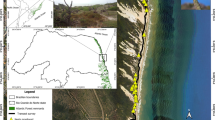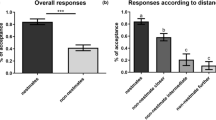Abstract
Studies on the behavioral and oviposition responses of Culex quinquefasciatus to 3-methylindole or skatole (an oviposition site cue) and (5R,6S)-6-acetoxy-5-hexadecanolide (the synthetic oviposition pheromone, SOP) were conducted in Muheza, northeast Tanzania. Cx. quinquefasciatus displayed a bimodal pattern of oviposition. The highest peak (64.8%) was between 18:00 and 20:00 hr, while the second peak (18.9%) was between 06:00 and 08:00 hr. The mean number of egg rafts oviposited per day between the two peaks was different (P < 0.05). Oviposition responses of gravid Cx. quinquefasciatus differed across the range of concentrations of skatole. Larger numbers of egg rafts were deposited in bowls treated with 10−6 μg or 10−5 μg skatole than in bowls with tap water (P < 0.05). The number of egg rafts deposited in bowls treated with 10−4 or 10−1 μg skatole was not different from that laid in tap water (P > 0.05). Under field conditions skatole was found to be effective for a period of seven days, after which its biological activity decreased significantly. It was further found that more egg rafts of Cx. quinquefasciatus were deposited in water treated with SOP than in water treated with skatole (P = 0.0002). An additive effect was observed when the SOP + skatole combination was used to attract gravid Cx. quinquefasciatus to oviposition sites. It is concluded that skatole and SOP mediate oviposition site selection of Cx. quinquefasciatus under field conditions.
Similar content being viewed by others
REFERENCES
Allan, S. A., and Kline, D. L. 1995. Evaluation of organic infusions and synthetic compounds mediating oviposition in Aedes albopictus and Aedes aegypti (Diptera: Culicidae). J. Chem. Ecol. 21:1847–1860.
Beehler, J. W., and Mulla, M. S. 1995. Effects of organic enrichment on temporal distribution and abundance of culicine egg rafts. J. Am. Mosq. Control Assoc. 11:167–171.
Beehler, J. W., Millar, J. G., and Mulla, M. S. 1994. Field evaluation of synthetic compounds mediating oviposition in Culex mosquitoes (Diptera: Culicidae). J. Chem. Ecol. 20:281–291.
Blackwell, A., Mordue (Luntz), A. J., Hansson, B. S., Wadhams, L. J., and Pickett, J. A. 1993. A behavioural and electrophysiological study of oviposition cues for Culex quinquefasciatus. Physiol. Entomol. 18:343–348.
Chadee, D. D., Connell, N. K., Lematre, A., and Ferreira, S. B. 1988. Surveillance for Aedes aegypti in Tobago, West Indies (1980–1982). Mosq. News 44:490–492.
Dawson, G. W., Mudd, A. L., Pickett, J. A., Pile, M. M., and Wadhams. J. 1990. Convenient synthesis of mosquito oviposition pheromone and a highly fluorinated analog retaining biological activity. J. Chem. Ecol. 16:1779–1789.
De Meillon, B., Sebastian, A., and Khan, Z. H. 1967. Time of arrival of gravid Culex pipiens fatigans at an oviposition site, the oviposition cycle and the relationship between time of feeding and time of oviposition. Bull. World Health Org. 36:39–46.
Edwards, F. W. 1942. Mosquitoes of the Ethiopian Region III. Culicine Adults and Pupae. Adlard and Sons, London.
Gillett, J. D. 1956. Initiation and promotion of ovarian development in the mosquito Aedes (Stegomyia) aegypti (Linnaeus). Ann. Trop. Med. Parasitol. 50:375–380.
Gillett, J. D. 1972. Common African Mosquitos and Their Medical Importance. William Heinemann Medical Books, London.
Gillies, M. T., and Coetzee, M. 1987. A supplement to the Anophelinae of Africa south of the Sahara (Afrotropical region). Publ. S. Afr. Inst. Med. Res. 55:1–143.
Haddow, A. J., and Gillett, J. D. 1958. Laboratory observations on the oviposition-cycle in the mosquito Taeniorhynchus (Coquillettidia) fuscopennatus Theobald. Ann. Trop. Med. Parasitol. 52:320–325.
Ikeshoji, T., Saito, K., and Yano, A. 1975. Bacterial production of the ovipositional attractants for mosquitoes on fatty acid substrates. Appl. Entomol. Zool. 10:239–242.
Isoe, J., and Millar, J. G. 1995. Characterization of factors mediating oviposition site choice by Culex tarsalis. J. Am. Mosq. Control Assoc. 11:21–28.
Jones, M. D. R. 1981. The programming of circadian flight-activity in relation to mating and the gonotrophic cycle in the mosquito, Aedes aegypti. Physiol. Entomol. 6:307–313.
Mboera, L. E. G., Mdira, K. Y., Salum, F. M., Takken, W., and Pickett, J. A. 1999. The influence of synthetic oviposition pheromone and volatiles from soakage pits and grass infusions upon oviposition site-selection of Culex mosquitoes in Tanzania. J. Chem. Ecol. 25:1855–1865.
Mboera, L. E. G., Takken, W., Mdira, K. Y., and Pickett, J. A. 2000. Sampling gravid Culex quinquefasciatus (Diptera: Culicidae) using traps baited with synthetic oviposition pheromone and grass infusions in Tanzania. J. Med. Entomol. 37:172–176.
Millar, J. G., Chaney, J. D., and Mulla, M. S. 1992. Identification of oviposition attractants for Culex quinquefasciatus from fermented Bermuda grass infusion. J. Am. Mosq. Control Assoc. 8:11–17.
Millar, J. G., Chaney, J. D., Beehler, J. W., and Mulla, M. S. 1994. Interaction of the Culex quinquefasciatus egg raft pheromone with a natural chemical associated with oviposition sites. J. Am. Mosq. Control Assoc. 10:374–379.
McHugh, C. P., and Hanny, P. A. 1990. Records of Aedes albopictus, Ae. aegypti and Ae. triseriatus from the U.S. Air Force ovitrapping program 1989. J. Am. Mosq. Control Assoc. 8:11–17.
Mordue, A. J., Blackwell, A., Hansson, B. S., Wadhams, L. J., and Pickett, J. A. 1992. Behavioural and electrophysiological evaluation of oviposition attractants for Culex quinquefasciatus Say (Diptera: Culicidae). Experientia 48:1109–1111.
Reiter, P. 1983. A portable battery-powered trap for collecting gravid Culex mosquitoes. Mosq. News 43:496–498.
Reiter, P. 1986. A standardized procedure for the quantitative surveillance of certain Culex mosquitoes by egg raft collection. J. Am. Mosq. Control Assoc. 2:219–221.
Reiter, P., Amador, M. A., and Colon, N. 1991. Enhancement of the CDC ovitrap with hay infusions for daily monitoring of Aedes aegypti populations. J. Am. Mosq. Control Assoc. 7:52–55.
Subra, R. 1981. Biology and control of Culex pipiens quinquefasciatus, Say, 1823 (Diptera: Culicidae) with special reference to Africa. Insect Sci. Appl. 4:319–338.
Suleman, M., and Shirin, M. 1981. Laboratory studies on oviposition behaviour of Culex quinquefasciatus Say (Diptera: Culicidae): choice of oviposition medium and oviposition cycle. Bull. Entomol. Res. 71:361–369.
Takken, W., and Knols, B. G. J. 1999. Odor-mediated behaviour of Afrotropical malaria mosquitoes. Annu. Rev. Entomol. 44:131–157.
Author information
Authors and Affiliations
Rights and permissions
About this article
Cite this article
Mboera, L.E.G., Takken, W., Mdira, K.Y. et al. Oviposition and Behavioral Responses of Culex quinquefasciatus to Skatole and Synthetic Oviposition Pheromone in Tanzania. J Chem Ecol 26, 1193–1203 (2000). https://doi.org/10.1023/A:1005432010721
Issue Date:
DOI: https://doi.org/10.1023/A:1005432010721




